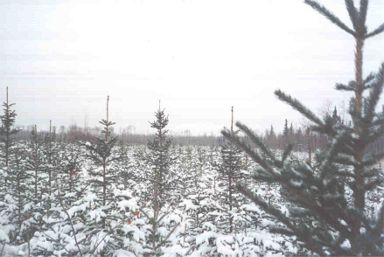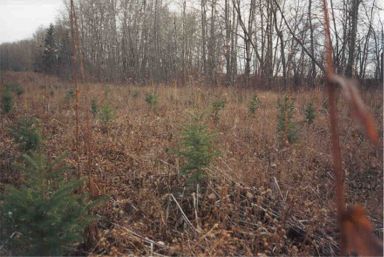| | Natural regeneration | Artificial regeneration | Site preparation | Direct seeding | Tree planting | Maintenance and monitoring
Forest regeneration is the process of forest renewal by natural or artificial means. Natural regeneration is by natural seeding, root sprouting and fire, while artificial regeneration is by direct seeding and seedling planting. Before starting any harvesting operation, the plan for regeneration should be in place. Regeneration is very important to assure long-term sustainable woodlot management.
Natural Regeneration
Consider natural regeneration first. It is low cost, and it uses seed from the local trees -- trees which are able to grow under the local conditions.
Forest naturally could be regenerated by seed or by suckering. This type of regeneration is mostly recommended for aspen and balsam poplar forest type. Other tree species could also be a naturally regenerated but several considerations should be taken into it.
The natural regeneration of hardwood and mixedwood sites by hardwood species such as trembling aspen and balsam poplar is accomplished easily through root suckering. The young seedlings need full light to stimulate roots to produce suckers. Therefore, reforestation of these species should include a harvesting method that creates large openings, usually clear-cutting.
In softwood and mixedwood sites, the success of natural regeneration of the softwoods will depend strictly on seeding. Many factors contribute to the success rate of regeneration from seed such as: site conditions, quality and quantity of the seed material, timing of harvest, seed source location relative to the cutover area, and weather.
Every tree species produces seed. Natural regeneration from seed depends on seed production from particular tree species, environmental conditions for seed germination and timing of disturbances such as harvesting or fire.
The differences among tree species in seed production are significant. White spruce usually produces seed every 2 to 5 years, black spruce every 3 years, tamarack every 3 to 6 years, and aspen and balsam poplar every year.
In some years, seed is just not produced; do not harvest during these years. Harvesting should only be done when trees produce enough seeds for natural regeneration. Keep this in mind if you decide on natural regeneration by seed.
Site conditions are very important for natural regeneration by seed. Available moisture, light exposure, mineral soil exposure, and competition from shrubs and grasses are some factors that should be consider for natural regeneration by seed. Soil exposure and reduction of competition from shrub and grass might be achieved through the harvesting. Movement of equipment and extraction of logs will disturb soil and damage shrub and grass layer.

Natural regeneration of white spruce
Source by: Vanderwell Contractors (1971) Ltd.
Artificial Regeneration
If natural regeneration has not been successful, then artificial regeneration is the only way to get the forest back. Some people confuse the terms "artificial regeneration" and "afforestation." Afforestation refers to forest cover establishment on sites where the forest has been previously eliminated or never existed. Artificial regeneration refers to a process of rebuilding a forest after logging, fire and other disturbances.
Artificial regeneration includes site preparation, direct seeding, seedling planting, or a combination of these activities.
Site preparation
Site preparation is a term used to describe the process of a mechanical, fire, chemical or other treatment that modifies the site to provide favorable conditions for natural or artificial regeneration. To obtain best survival and growth for new forest, site preparation is sometimes necessary. Without site preparation, surrounding vegetation will usually compete with the seedlings for light, nutrients and moisture. Therefore site preparation is sometimes critical to ensure seedling survival.
The goal of the site preparation is to:
- Provide suitable site for seed germination or for planting seedlings
- Disturb soil without causing any excessive damage.
- Control the competing vegetation.
- Increase soil temperature
- Reduce slash
The level of site preparation depends on the site conditions. Many times disturbances created by harvesting could be enough for site preparation. Sites preparation can be done mechanically, manually or by using herbicides.
Scarification is the one of the most common site preparation practices. It exposes the mineral soil to create microsites for seedlings or seed. It also reduces or eliminates competing vegetation, increases soil temperature, improves moisture, reduces risk of frost, and exposes seedlings to more light.
Light scarification with an anchor chain is commonly used on dry sites (such as jack pine sites) and it may be sufficient for this type of site.
Disc trenching is a common site preparation treatment. It exposes and mixes the soil and removes all shrub and tree competition.
Other site preparation treatments such as manual cutting or brushing or using herbicides are sometimes used to reduce vegetative competition on site.
Depending on the site conditions, site preparation could be a major cost of regeneration.
Direct seeding
Direct seeding may be required in a clear-cut area or in area where no natural sources of seed are present. Choosing seed from the local area is the best solution. Seeds from sites with different conditions may not thrive at your site. Direct seeding can be accomplished by broadcasting the seed on the forest floor or by hand seeding on a suitable seedbed. The results of direct seeding can be quite variable. In some cases, the cost of seeding might be higher than planting seedlings, depending on the cost of seed and whether site preparation is necessary or not.
Tree planting
The tree planting is used to establish or re-establish a forest in one of three main situations:
- When natural regeneration of coniferous species has failed after harvesting, fire or other disturbances and only tree planting will bring the forest back.
- When you want to introduce a coniferous species under an existing hardwood forest. This operation is usually called underplanting.
- When you want to afforest a new area.
Before tree planting, consider species selection, planting stock selection, spacing, time of the planting, site selection/microsite selection and planting technique.
- Species selection - Species selection should be based on the qualities of the site, the chance of successfully establishing the species, and your goals for the woodlot. For example, if your goal is to get valuable forest products such as veneer logs and sawlogs, then white spruce would be best. Many nurseries Alberta will provide trees and shrub species to landowners.
- Selecting planting stock - There are four types of planting stocks: container seedlings (plugs), barefoot, transplant seedlings and cuttings. Most of the time, plugs are used for tree planting. The size and age need to be considered when choosing planting stock. The size of the planting stock chosen depends on cost of stock and the weed competition. Larger sizes are more able to compete with weeds. Most tree seedlings are now only available as container types. Larger and older stock is more expensive to buy and plant. All stock should originate from areas with the same or similar environmental conditions as those of the planting site. Ideally, stock should come from the same ecoregion as the planting site. Stock from similar nearby areas would be preferable to stock from similar distant areas.
- Planting time - Spring is the preferred planting time because there is more available moisture for the trees. Planting should begin when the soil temperature is greater than 4 C, before shoot growth and after frost has left ground. Planting can also be done in the fall but spring planting will improve winter survival because of the better root development. Fall-planted trees are also more susceptible on frost damage and damage from rodents and other wildlife than spring-planted trees.
- Tree spacing - Spacing is determined by the tree species and purpose of the planting. Usually trees are planted in equally spaced rows. Optimal spacing and stocking varies from species to species. The goal is to plant enough trees to fully utilize the site while providing enough growing space and avoiding a noncommercial thinning to maintain plantation vigor. No single spacing is ideal for satisfying all planting objectives. A typical spacing for white spruce is 6 x 6 feet (2 x 2 m), about 2,400 trees per ha. Wide spacing produces large lateral branches and poor form. Spacing in underplanting depends on the density of the residual timber. There is no typical understory spacing; it could vary between 8 and 12 feet (2.4 and 3.6m), about 1400 trees per hectares. Shelterbelts and afforested areas may use tighter spacing.
Table 1. Common tree spacing in Alberta
Trees per hectares | Trees per acres |
Centimeters | Number of trees | Feet | Number of trees |
120x120 | 6944 | 3x3 | 2811 |
180x180 | 3086 | 5x5 | 1249 |
200x200 | 2400 | 6x6 | 1012 |
210x210 | 2268 | 7x7 | 918 |
240x240 | 1736 | 8x8 | 703 |
270x270 | 1372 | 9x9 | 555 |
300x300 | 1111 | 10x10 | 450 |
360x360 | 772 | 12x12 | 313 |
- Site selection-microsite- Microsite selection includes factors such as drainage, organic matter, level of competition, light and wind exposure, and predation by animals. If tree species are planted on unsuitable sites, they will suffer high mortality, grow poorly and be more susceptible to insect and disease problems.
- Planting technique- Seedlings can be –planted by hand or mechanically. The most common hand planting methods use a dibble, shovel or planting bar. A tree-planting machine pulled by tractor usually does mechanical planting.

4 years old white spruce plantation
Source by: Vanderwell Contractors Ltd.
For a variety of tree and shrub species check Silvics of North America web site.
For Alberta specific information check Shelterbelt Varieties for Alberta.
Maintenance and monitoring
After the forest is established either naturally or artificially, follow-up and monitoring are necessary. Follow-up usually consists of eliminating weed competition and protecting the young forest from fire, grazing, wildlife, diseases and insects.
Weed control is very important in the early stage and often means the difference between success and failure of forest establishment. Weed control might be accomplished by using herbicides or mechanical removal. Herbicide use will depend on the tree species characteristics and the type of unwanted vegetation.
If trees start to change the color of their foliage, drop needles, or the leaves are eaten, then some insects or diseases are present. Once you detect and identify the cause of the problem, some control measures may be needed to prevent serious damage.
For more about insect pests and diseases go to Woodlot Pest Management. |
|